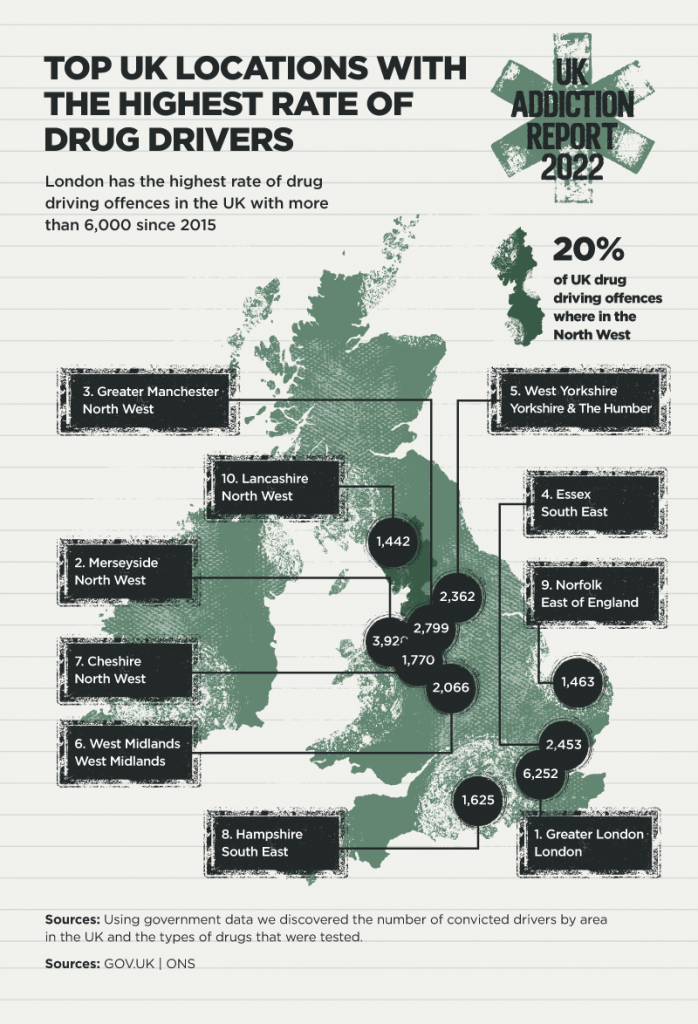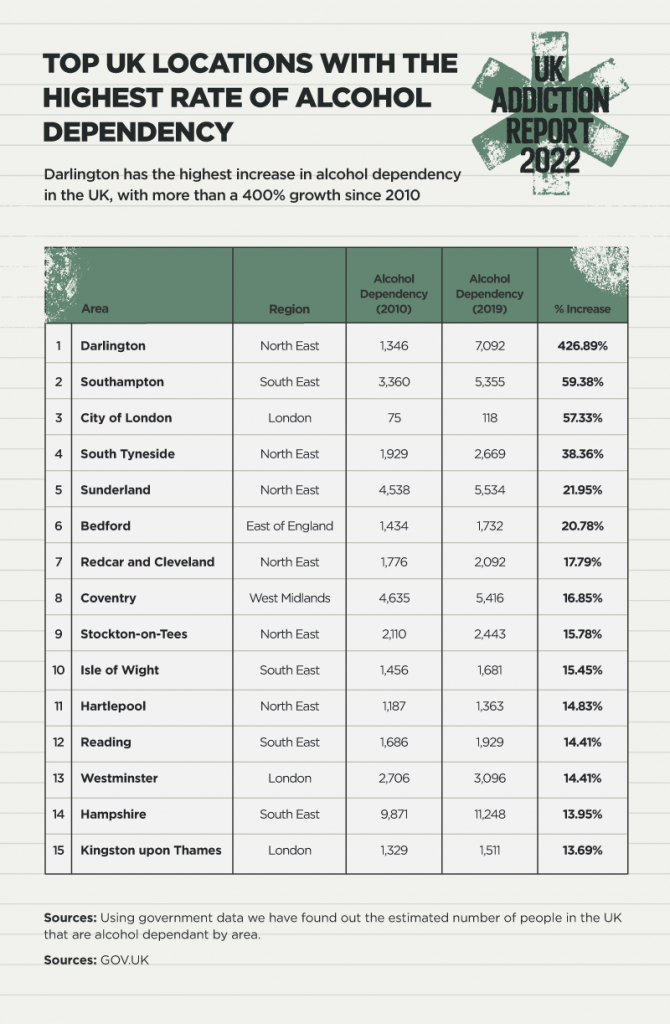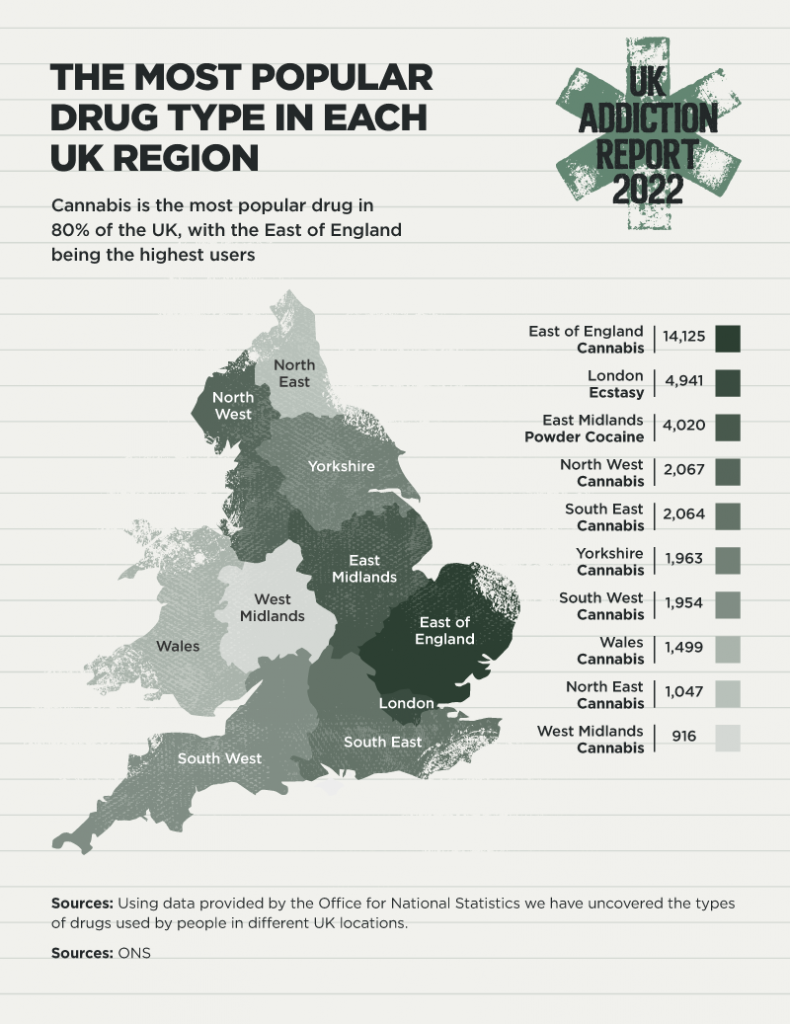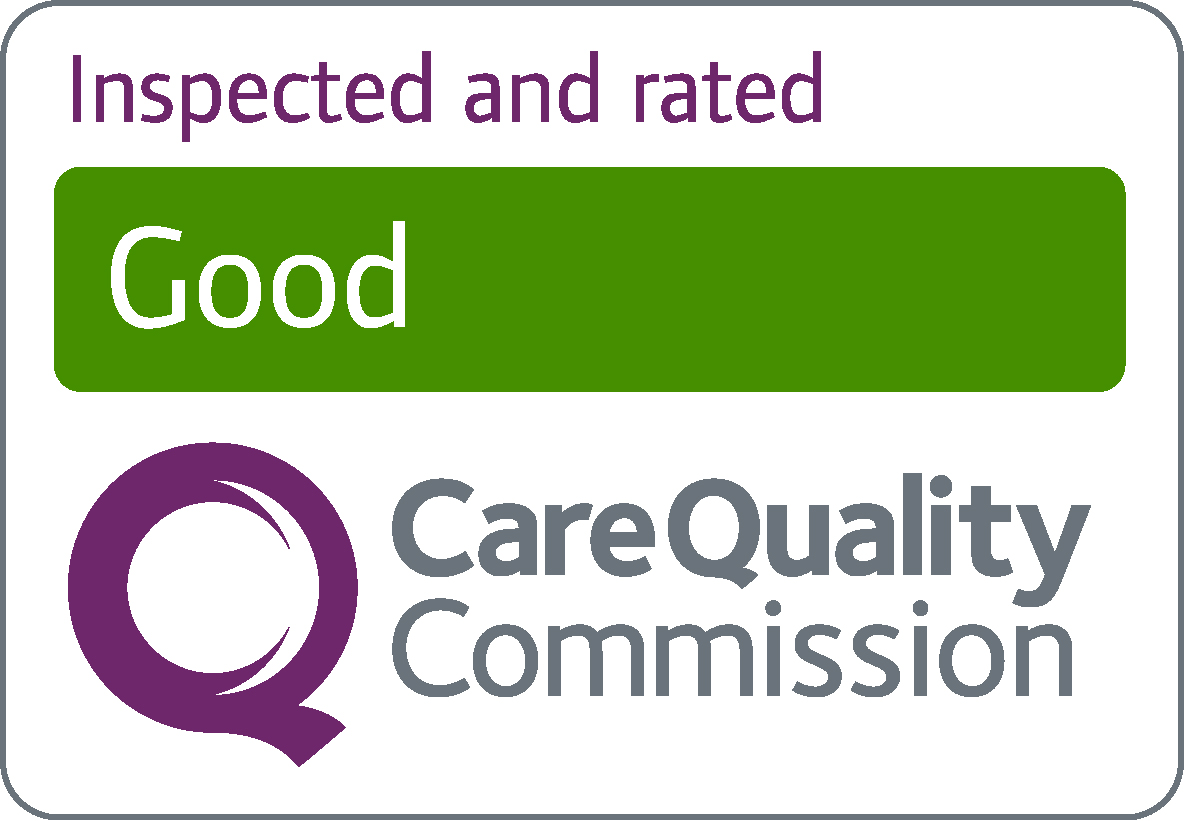UK Drug Addiction Report 2022

on 04 Mar 2022
- Locations With the highest rate of drug drivers
- The UK Areas With The Highest Increase In Drug Arrests
- Top UK Locations With The Highest Rate of Alcohol Dependency
- How the pandemic has impacted alcohol-related hospital admissions across the UK
- The Most Popular Drug Type in Each UK Region

Here in the UK, drugs are often introduced in a social or party context. Though at face value this may seem harmless, The Centre for Social Justice has claimed that the level of substance dependency in the UK means that it has become the ‘addiction capital of Europe.’
With an estimated 29.2 million drinking alcohol weekly, and 313,971 drug users (aged 15 to 64) across the UK, millions of lives are changed by dependency year upon year. However — what is really known about the impact of addiction across the country?
Our team of addiction specialists have compiled an in-depth analysis of drug and alcohol use throughout the UK to assess the various ways in which addiction affects people’s lives across the UK.
Locations With The Highest Rate of Drug Drivers
Operating a motorised vehicle while intoxicated is a serious crime. This is because it lowers your inhibitions, slows down your reactions, and impedes your ability to make informed decisions.
The legal alcohol limit in England, Wales, and Northern Ireland for driving is 80 milligrams of alcohol per 100 millilitres of blood — or 35 micrograms of alcohol per 100 millilitres of breath. This translates to two pints of regular-strength lager or two small glasses of wine (roughly equivalent to 4.5 units of alcohol).
Furthermore, when it comes to drug driving, UK lawmakers operate a zero tolerance approach — this includes medically prescribed drugs.
Nonetheless, in the same way many drivers misjudge the amount of alcohol in their system, drug drivers may assume that they are more capable than they really are. This can result in them getting behind the wheel of a vehicle at a time when they risk causing harm to themselves or others.
When examining drug driving statistics throughout the UK, we found that Greater London is the capital for drug driving offences — with 6,252 recorded since 2015.
The second-highest rate of drug drivers in the UK is in Merseyside, in the North West — this includes areas such as Liverpool and St. Helen’s. Since 2015, there have been 3,920 drug-driving related convictions in the Merseyside region.
Our research shows the third-highest rate of drug drivers is also in the North West — this time in Greater Manchester. Here, there have been a reported 2,799 drug driving convictions since 2015.
In terms of accessibility to drugs in these regions, Greater Manchester is also the region with the second-highest rate of drug seizures in the UK. Since 2010, there have been a colossal 91,148 drug-related seizures by local police forces — making it second only to the UK capital.
Since 2015, the drug most commonly recorded in the bloodstream of drivers under the influence is tetrahydrocannabinol. This is a psychoactive substance found in cannabis — known for producing the ‘high’ feeling associated with smoking the drug. Within the same timeframe, there have been 40,281 arrests associated with drivers who have tetrahydrocannabinol in their systems.
The second most common drug recorded in drug drivers is benzoylecgonine — the main metabolite of Class A drug, cocaine. There have been 21,461 driver arrests linked to this drug since 2015.
Catherine Carney, a Delamere psychiatrist and addiction specialist, says of the findings:
“Ironically, it can be the very same impaired judgement caused by the presence of drugs in the bloodstream that influences a motorist’s decision to drive while intoxicated.
“Not only do drugs interfere with your ability to make informed decisions — they also slow down your reaction times, reduce your concentration, and alter the way you process information. Drugs also severely affect your ability to multitask — something that operating a vehicle requires you to do at all times.
“Making the decision to drive while under the influence of an illegal substance isn’t just harmful to yourself — it also poses a serious risk for those around you, too. In fact, one in 20 road fatalities is caused by drug driving.
“If you become aware of a drug driver, or worry that you yourself may be unfit to operate a vehicle — whether due to drugs prescribed by your doctor or an illegal substance — your decision to not drive, or intercept a drug driver, could save someone’s life.”

The UK Areas With The Highest Increase In Drug Arrests
Also in our research, we examined the UK regions that have experienced the highest increase in drug-related arrests.
The results indicated Leicestershire — situated in the East Midlands — as the area in which drug arrests have increased the most during the pandemic. This area has seen a dramatic 83.67% rise in drug-related arrests since the global health crisis began back in 2020.
The second-highest increase in UK drug arrests is in Cleveland, Yorkshire. Here, the number of individuals apprehended for drug-related issues has risen by an incredible 83.42% throughout the pandemic.
Towards the South East of England, in Essex, arrests in connection with drug use and distribution have seen a 76.62% increase — rising from 4,111 arrests prior to the pandemic, to figures as high as 7,261 in 2020/21.
From looking at the aforementioned figures, it can be deduced that drug use in the UK has rapidly increased since the global health crisis first emerged back in 2020.

Here’s what Delamere’s Founder and Chief Executive at Delamere, Martin Preston, has to say on substance abuse throughout the pandemic:
“It’s during times of stress and uncertainty that mind-altering substances become more attractive to individuals — for the simple reason that they offer an escape from the current reality.
“When considering this, it’s easy to understand why drug use in the UK may have spiked since the onset of the pandemic.
“Other factors that may have influenced the spike include increased free time, boredom, feelings of isolation, changes in habits — and dramatic events such as loss of income or the passing of a loved one.
“Furthermore, the COVID-19 pandemic also resulted in a lack of access to valuable support services — as well as support networks. With this in mind, active drug users were more likely to self-medicate, and those in recovery from substance abuse had an increased risk of relapse.”
Top UK Locations With The Highest Rate of Alcohol Dependency
Here in the UK, drinking is a huge part of our culture. From socialising with friends and colleagues, to networking and conducting business matters, people often rely on alcohol to relax tensions.
However, this isn’t to say that drinking in the UK isn’t problematic. In fact, in many instances, it’s this casual relationship with alcohol that can lead to much more serious implications.
In a survey carried out by the team here at Delamere, it was found that during the pandemic, almost two thirds (60%) of UK residents where drinking alone. In the same report, it was found that the biggest pandemic drinking increase was found in those aged 18-24, with almost a third (32%) saying they had started drinking more in the past year.
Regarding the UK location with the highest increase in alcohol dependency, research showed an alarming rise in the North Eastern town of Darlington. This area experienced an increase of more than 400% in the space of just 10 years. Furthermore, in 2010, government data indicated that the region was home to an estimated 1,346 people with a dependant relationship with alcohol. Just under a decade later, in 2019, this figure had risen to a startling 7,092.
This increase in alcohol dependency isn’t limited to the North of England — with rates of alcoholism also rising on the opposite side of the country, in Southampton. Statistics show that this coastal city has seen a 59.38% increase in alcohol dependency throughout the last decade – the second-highest increase in the UK.
Also in the south, The City of London has experienced a concerning rise in alcohol dependency rates since 2010. At an increase of 57.33%, England’s capital is the third-highest ranking area in rising alcohol dependency levels.
Once again, we consulted our Founder and Chief Executive, Martin Preston, on our findings:
“Sadly, it’s clear that alcohol dependency continues to be a huge problem throughout the UK — and the same can be said for drug addiction.
“The fact that alcoholism has seen a steady rise over the past decade indicates much wider issues in terms of the root cause of alcohol addiction.
“As discussed, factors that influence alcohol addiction can be social — for instance, events with friends or business colleagues. No matter your age, company role, or status, in these situations, it can be easy to feel pressured to fit in with or impress your peers.
“The other big cause of alcohol dependency is simple — impulsivity. Alcohol can seem very attractive as it reduces our inhibitions and gives us the illusion we have more freedom to truly express ourselves. In the same way, many heavy drinkers will have little foresight or regard for the consequences of their drinking in the moment.
“At Delamere, we take a person centred approach to overcoming alcoholism — meaning the individual experience of the client is paramount. We find this to be successful in tackling the “Why?” behind someone’s addiction problem before we work towards a solution”.

How the pandemic has impacted alcohol-related hospital admissions across the UK
Since the beginning of the pandemic, alcohol-related admissions have seen a dramatic reduction. In fact, across the UK, there has been a 70% decline in alcohol-related hospitalisations.
This is a staggering figure — even more staggering is the drop of alcohol-related admissions in the UK’s most populated region, London. At 74.61%, England’s capital has seen the largest drop in admissions throughout the whole of the UK.
In the North West of England — the location of densely populated cities such as Liverpool and Manchester — alcohol-related hospital admissions have also seen an overwhelming decrease of 73.76%.
Across the country, alcohol-related hospital admissions are at an all-time low. This fact even applies to the East Midlands — an area which has seen the lowest reduction in admission rates. Here, hospital admissions have decreased by 64.71% — with figures dropping from 67,800 in 2017/18, to just 23,930 in 2020/21.

Catherine Carney, Delamere’s psychiatrist and addiction specialist, says of the findings:
“On the face of it, a decrease in alcohol-related hospital admissions appears to be a positive outcome. However, upon deeper inspection, it’s clear that this is not necessarily the case.
“During the pandemic, ready access to health and social care was much more restricted — this meant routine hospital services were also very restricted.
“In order to prioritise access to hospital beds for those fighting COVID-19, other health services were replaced with telephone or online consultations — or postponed entirely. In addition, hospital staff were redeployed or limited in their abilities due to a stark increase in their workload.
“In this context, it’s also worth noting that alcohol deaths throughout the UK rose to an all-time high in 2020. From this statistic alone, it’s clear that the dramatic decline in alcohol-related hospital admissions sadly had fatal consequences for far too many people.”
The Most Popular Drug Type in Each UK Region
When conducting our research, we also determined the most popular drug throughout the UK. Unsurprisingly, cannabis is the most widely used illegal substance in 80% of UK regions.
Our research found that cannabis consumption is most prevalent in the East of England — with data indicating 14,125 reported users of the drug. Nonetheless, this does not mean that cannabis is safe to use.
Like many drugs, cannabis has a wide variety of names — like marijuana, weed, and pot — and its effects can vary from person to person. Nonetheless, the substance is highly addictive — and since smoking involves regular use of tobacco, cannabis use also increases the risk of cancer and coronary heart disease.
Unsurprisingly since it is the most popular drug in the UK, cannabis is also the substance most often seized by police — with a reported 1,617,706 cannabis-related seizures since 2010. Other cannabis seizures by police include herbal cannabis — which has been confiscated by police forces 1,405,947 in just over a decade.
Other UK regions where cannabis use is highly prevalent include the North West of England — here, the reported usage is 2,067. Elsewhere, in the South East of England, a similarly high usage was reported — at 2,064.
In London — a city known for its varied and colourful nightlife — the most popular drug is MDMA. More colloquially known as ‘ecstasy’ due to the feelings of euphoria that it triggers, MDMA was reported as the go-to stimulant for 4,941 Londoners. In fact, London is the only UK region in which ecstasy is the most popular drug.
Outside of The City of London, in the Greater London boroughs, there have been 554,556 drug seizures by police since 2010. This makes the southern ceremonial county the area with the highest rate of drug seizures in the UK.

The East Midlands is the UK region that covers Derbyshire, Leicestershire, Lincolnshire, Northamptonshire, Nottinghamshire, and Rutland — it’s also the region in which powdered cocaine is found to be the most popular recreational substance. In this area, there is a reported usage of 4,020 for the euphoriant — according to our data, The East Midlands is the only region in the UK where powdered cocaine is the most commonly used substance..
Overall, the two countries in the UK that have seen the sharpest increase in drug seizures by police are both areas in which cannabis use is highly prevalent. The first is Lincolnshire, in the East of England. Here, the use of cannabis is more popular than anywhere else in the UK — in addition, at 273%, Lincolnshire has seen the highest percentage increase in drug seizures by police foces. The latter county is in the North, in Lancashire, where there has been a reported increase in seizures by 191%. Also in Lancashire, cannabis is the most used substance..
Elsewhere in the UK, other substances that continue to be popular include the benzodiazepines family. More commonly referred to as ‘benzos’, benzodiazepines are medically prescribed for anxiety and sleeping problems, and are usually safe for short-term prescription use. However, when distributed as a street drug, they can be highly dangerous. Not only have benzodiazepines led to a 69% increase in drug seizures by police, they also commonly cause drug-related hospitalisations, and even deaths.
Another widely used drug throughout the UK is the powerful hallucinogenic, LSD — also known as ‘acid’. In terms of police seizures, our research shows that police confiscations have increased by a shocking 207% since 2010.
Martin Preston, Founder and Chief Executive at Delamere, says of the findings:
“As a Class B drug, cannabis can often be easier to access than other drugs that are considered to be more harmful by Parliament — such as crack cocaine or heroin. This could explain cannabis’ popularity throughout the UK.
“However, cannabis dependency is still very much a risk for users — with one in 10 regular cannabis users becoming dependent on the drug.
“When it comes to drugs that are more harshly penalised, the danger isn’t just the strength of the drugs themselves — but also the other ‘cutting agents’ that may be included in the measurement.
“Whereas medication prescribed by a doctor is carefully regulated for a patient’s protection, drug dealers seeking to make a profit will mix the drug with additives that can in fact be dangerous toxins to meet their bottom line.
“Different additives will cause varying effects, and it’s impossible to tell the type and level of filler ingredients contained in a batch of cocaine. This increases the risk of negative reactions to substances — and in some cases, even fatalities.”
References
Top UK Locations With The Highest Rate of Drug Drivers – Using government data we have discovered the number of convicted drug drivers by area in the UK from 2015 to 2020.
The UK Areas With The Highest Increase In Drug Arrests – Using data provided by the House of Commons we have uncovered the increase or decrease in drug offences committed in England by area from 2019 to 2021.
Top UK Locations With The Highest Rate of Alcohol Dependency – Using government data we have found out the number of people in the UK that are alcohol dependant by area.
How the pandemic has impacted alcohol-related hospital admissions – Using data from Public Health England we have uncovered data how many alcohol-related hospital admissions there are in the UK by area.
The Most Popular Drug Type in Each UK Region – Using data provided by the Office for National Statistics we have uncovered the types of drugs used by people in different UK locations.

About the author: Martin Preston
Martin created Delamere in order to provide exemplary care in first class facilities. Find out more about Martin on our team page.
RECENT POSTS
The Power of Reaching out a HandFrom sobriety to quality of life: Revisiting recovery outcome measures
The role of alcohol in UK culture, and how to break free
Holistic diet tips to balance energy and mood
CATEGORIES
-
Addiction Recovery
Addiction Reports
Alcohol Addiction
Burnout
Delamere
Digital Addiction
Drug Addiction
Holistic Programmes
Other Behaviours
Prescription Drug Addiction
Rehab
ARCHIVES
- December 2025
- November 2025
- October 2025
- September 2025
- August 2025
- July 2025
- June 2025
- May 2025
- April 2025
- March 2025
- February 2025
- January 2025






